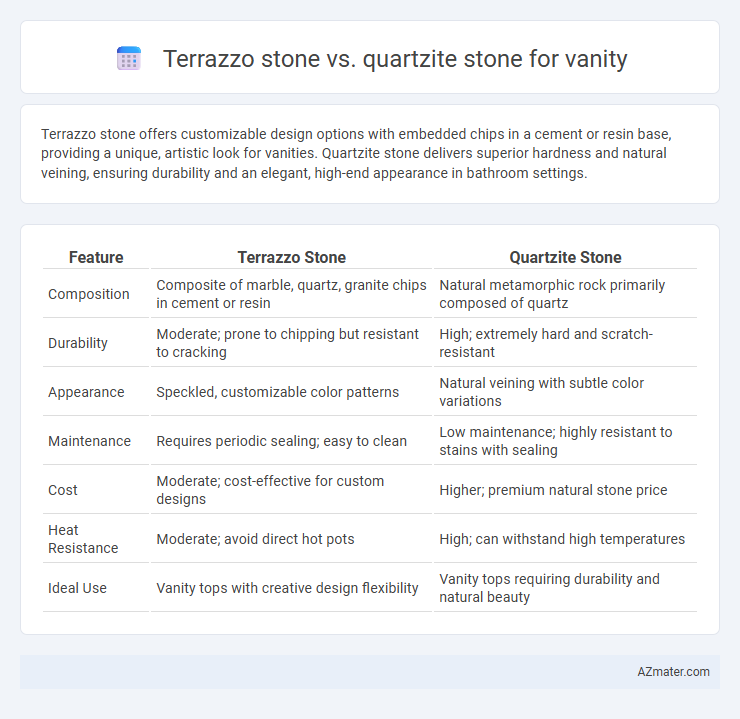Terrazzo stone offers customizable design options with embedded chips in a cement or resin base, providing a unique, artistic look for vanities. Quartzite stone delivers superior hardness and natural veining, ensuring durability and an elegant, high-end appearance in bathroom settings.
Table of Comparison
| Feature | Terrazzo Stone | Quartzite Stone |
|---|---|---|
| Composition | Composite of marble, quartz, granite chips in cement or resin | Natural metamorphic rock primarily composed of quartz |
| Durability | Moderate; prone to chipping but resistant to cracking | High; extremely hard and scratch-resistant |
| Appearance | Speckled, customizable color patterns | Natural veining with subtle color variations |
| Maintenance | Requires periodic sealing; easy to clean | Low maintenance; highly resistant to stains with sealing |
| Cost | Moderate; cost-effective for custom designs | Higher; premium natural stone price |
| Heat Resistance | Moderate; avoid direct hot pots | High; can withstand high temperatures |
| Ideal Use | Vanity tops with creative design flexibility | Vanity tops requiring durability and natural beauty |
Introduction to Terrazzo and Quartzite Stones
Terrazzo stone is a composite material consisting of marble, quartz, granite chips bound with cement or epoxy resin, known for its durability and customizable patterns ideal for vanity surfaces. Quartzite stone is a natural metamorphic rock formed from sandstone, prized for its hardness, resistance to heat, and unique veining, making it a premium choice for bathroom vanities. Both materials offer distinct aesthetics and functional benefits, with terrazzo providing a versatile, artistic look and quartzite delivering a natural, elegant appearance.
Composition and Material Differences
Terrazzo stone is a composite material made from chips of marble, quartz, granite, glass, or other suitable materials, bound together with cement or epoxy resin, providing a highly customizable and colorful surface. Quartzite stone is a natural metamorphic rock primarily composed of quartz grains fused under heat and pressure, offering exceptional hardness and durability. The key difference lies in terrazzo's engineered mix allowing varied aesthetics, while quartzite's organic quartz-rich makeup delivers superior strength and natural stone appeal for vanity surfaces.
Visual Aesthetics: Patterns and Colors
Terrazzo stone offers a unique visual appeal with its vibrant, multi-colored chips embedded in a contrasting binder, creating customizable and artistic patterns ideal for vanity surfaces. Quartzite stone features natural veining and subtle color variations, ranging from soft neutrals to bold hues, providing an elegant and timeless look. The choice between terrazzo's playful, modern aesthetic and quartzite's sophisticated, natural beauty depends on the desired style and color palette for the vanity design.
Durability and Longevity Comparison
Terrazzo stone offers exceptional durability due to its composite nature, combining marble chips with a cement or resin binder, making it resistant to cracks and stains ideal for vanity surfaces. Quartzite stone is renowned for its natural hardness and resistance to scratching, heat, and etching, providing superior longevity and maintaining a polished appearance over time. Both materials perform well under daily use, but quartzite typically outlasts terrazzo in terms of wear resistance and long-term structural integrity.
Maintenance and Cleaning Requirements
Terrazzo stone requires regular sealing and non-abrasive cleaners to maintain its polished surface and prevent staining, making upkeep moderately demanding. Quartzite stone offers higher durability and resistance to scratches and acids, requiring less frequent sealing and simple cleaning with mild soap and water. Both materials benefit from prompt spill cleanup, but quartzite's hardness ensures easier maintenance over time for vanities.
Cost and Value for Vanity Surfaces
Terrazzo stone offers a cost-effective option for vanity surfaces, typically priced between $30 and $70 per square foot, delivering durability and customizable design options that enhance long-term value. Quartzite stone commands a higher investment, ranging from $60 to $100 per square foot, known for its natural hardness, resistance to heat, and unique veining patterns that increase property value. Choosing between Terrazzo and Quartzite depends on budget constraints and desired luxury, with Terrazzo providing affordability and style versatility, while Quartzite offers premium aesthetics and superior durability.
Environmental Impact and Sustainability
Terrazzo stone incorporates recycled glass and marble chips set in cement or resin, making it highly sustainable by reducing waste and utilizing eco-friendly materials. Quartzite is a natural stone formed over millions of years, offering durability but with a higher environmental cost due to quarrying and energy-intensive extraction. Terrazzo's recyclable components and lower carbon footprint often make it a more environmentally responsible choice for vanities compared to the energy demands of processing quartzite.
Installation Process and Challenges
Terrazzo stone installation involves embedding chips of marble, quartz, or glass in cement or resin, requiring skilled labor to achieve a smooth, polished surface and avoid cracks during curing. Quartzite stone installation demands precise cutting and careful handling due to its high hardness and brittleness, necessitating specialized tools and techniques to prevent chipping or fracturing. Both materials require professional expertise to ensure durable, aesthetically pleasing vanity surfaces, with terrazzo posing more challenges in curing control and quartzite in cutting accuracy.
Suitability for Bathroom Vanities
Terrazzo stone offers exceptional durability and resistance to moisture, making it highly suitable for bathroom vanities exposed to water and humidity. Quartzite stone boasts a natural hardness and non-porous surface, providing excellent stain resistance and longevity for bathroom vanity tops. Both materials deliver aesthetic versatility, but terrazzo's composite nature allows for customizable color patterns, while quartzite presents unique, natural veining ideal for a luxurious bathroom design.
Final Verdict: Choosing Between Terrazzo and Quartzite
Terrazzo stone offers vibrant, customizable patterns with a smooth, durable surface ideal for vanity tops seeking a unique aesthetic and moderate maintenance. Quartzite stone provides superior hardness, natural veining, and exceptional resistance to heat and scratches, making it perfect for high-traffic bathrooms requiring longevity and minimal upkeep. Selecting between terrazzo and quartzite for a vanity depends on prioritizing either artistic design flexibility or unparalleled durability and natural elegance.

Infographic: Terrazzo stone vs Quartzite stone for Vanity
 azmater.com
azmater.com